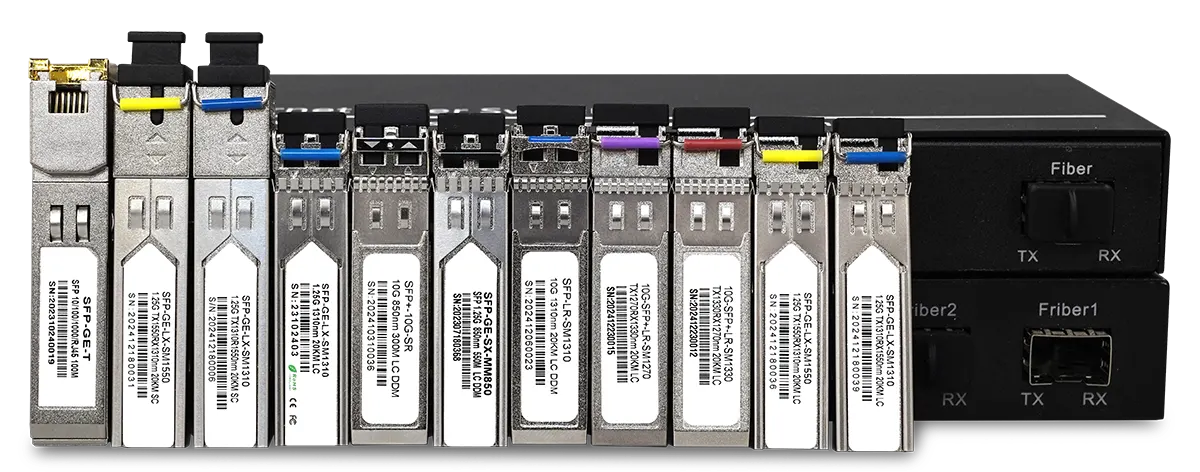SFP modules, or Small Form-factor Pluggable modules, are essential components in modern networking, enabling high-speed data transmission over fiber optic or copper cables. Understanding the different SFP modules types, their specifications, and key differences is crucial for optimizing network performance. This guide will provide a detailed overview of SFP modules, helping you make informed decisions for your networking needs.
What Are SFP Modules?
SFP modules are compact, hot-swappable transceivers used in network devices like switches, routers, and network interface cards. They support data rates ranging from 100 Mbps to 25 Gbps and are designed for flexibility, allowing network administrators to choose the appropriate module based on distance, bandwidth, and media type.

Types of SFP Modules
When it comes to SFP modules types, there are several categories based on their functionality, media type, and transmission distance. Below are the most common types:
1. SFP (Standard SFP)
- Data Rate: Up to 1 Gbps
- Media Type: Fiber optic or copper
- Distance: Up to 550 meters (multimode fiber) or 120 km (single-mode fiber)
- Use Case: Ideal for short to medium-distance connections in enterprise networks.
2. SFP+ (Enhanced SFP)
- Data Rate: Up to 10 Gbps
- Media Type: Fiber optic or copper
- Distance: Up to 300 meters (multimode fiber) or 80 km (single-mode fiber)
- Use Case: Suitable for high-speed data centers and enterprise networks.
3. QSFP (Quad SFP)
- Data Rate: Up to 40 Gbps
- Media Type: Fiber optic
- Distance: Up to 150 meters (multimode fiber) or 10 km (single-mode fiber)
- Use Case: Designed for high-density, high-speed applications like data centers.
4. QSFP+ and QSFP28
- Data Rate: Up to 100 Gbps (QSFP28)
- Media Type: Fiber optic
- Distance: Up to 10 km (single-mode fiber)
- Use Case: Used in next-generation data centers and high-performance computing.
5. BiDi SFP (Bidirectional SFP)
- Data Rate: Up to 1 Gbps or 10 Gbps
- Media Type: Single-mode fiber
- Distance: Up to 120 km
- Use Case: Ideal for networks where fiber strands are limited, as they use a single fiber for both transmission and reception.
6. CWDM and DWDM SFP
- Data Rate: Up to 10 Gbps
- Media Type: Single-mode fiber
- Distance: Up to 80 km (CWDM) or 120 km (DWDM)
- Use Case: Used in wavelength-division multiplexing (WDM) networks to increase bandwidth capacity.
7. Copper SFP
- Data Rate: Up to 1 Gbps
- Media Type: Copper (RJ45 connector)
- Distance: Up to 100 meters
- Use Case: Suitable for short-distance connections in office environments.
Key Specifications of SFP Modules
When selecting SFP modules, consider the following specifications:
- Data Rate: Determines the speed of data transmission (e.g., 1 Gbps, 10 Gbps).
- Wavelength: Measured in nanometers (nm), it affects the transmission distance and compatibility.
- Transmission Distance: Varies based on the type of fiber and module.
- Connector Type: Common types include LC (fiber) and RJ45 (copper).
- Operating Temperature: Commercial (0°C to 70°C) or industrial (-40°C to 85°C).
Key Differences Between SFP Modules Types
Understanding the differences between SFP modules types is essential for selecting the right one:
- Speed: SFP supports up to 1 Gbps, while SFP+ supports up to 10 Gbps, and QSFP+ supports up to 40 Gbps.
- Distance: Single-mode modules offer longer distances compared to multimode modules.
- Media: Fiber-based modules are ideal for long distances, while copper modules are better for short distances.
- Cost: Copper SFPs are generally cheaper than fiber-based SFPs, but they offer limited distance and speed.
Choosing the Right SFP Module
To choose the right SFP module, consider:
- Network Requirements: Speed, distance, and bandwidth.
- Compatibility: Ensure the module is compatible with your network equipment.
- Budget: Balance performance needs with cost constraints.
Conclusion
SFP modules are versatile and critical components in modern networking. By understanding the different SFP modules types, their specifications, and key differences, you can optimize your network for performance, reliability, and scalability. Whether you’re upgrading a data center or setting up a small office network, selecting the right SFP module is essential for achieving your goals.
For more information on SFP modules types and their applications, explore our comprehensive product catalog or contact our experts today!
